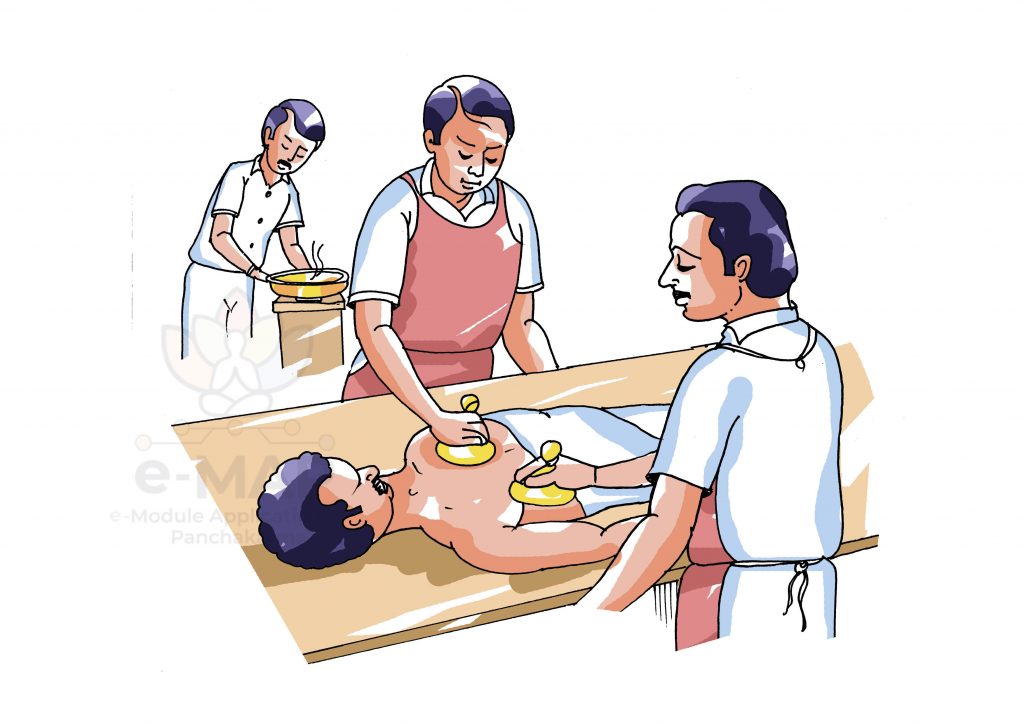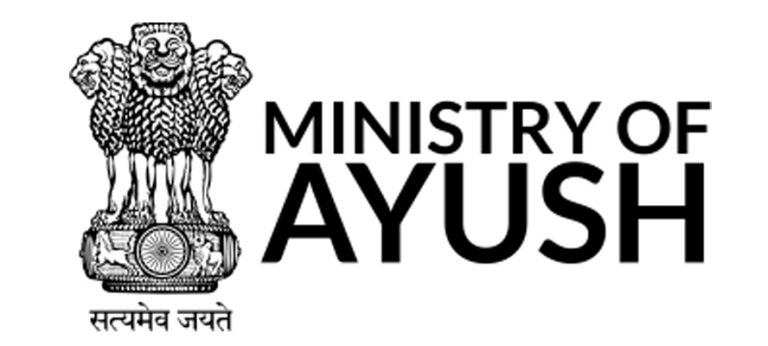
PG Module 3
SVEDANA

EXPLANATORY NOTES
The word “PatraPoṭṭali” is derived from two words, Patrameans leaves and Poṭṭalimeans bundle. PatraPoṭṭaliSveda refers to the sudation performed by specially prepared bundle of medicinal leaves (generally Vātakaphāhāra). It is a form of ŪṣmaSveda.
Materials required:
- VātāhāraPatras–Arka, Eraṇḍa, Nirgundi, Agnimantha,Dhattura,Vātaghni,Ciñca,
Śigru, Vasa, Karanja etc (any six types) – 50 gms eachchopped into pieces
- Grated coconut- 100g (half piece grated)3. Sliced lemon – 2 4. Cotton cloth (45 cm X 45cm): 4 pieces 5. Tags – 4 6. Vessels (for frying leaves and for heating poṭṭalis) – 27. Oil
For frying leaves – 50 ml ApakvaTaila; For heating Poṭṭalis – 120ml For Abhyaṅga– 80 ml For Talaṃ – 10 ml
8.Cūrṇa
Saindhava– 20gms
Śatapuṣpa– 10 gms
Haridra– 10 gms
Methika– 10 gms
Rāsnā– 10 gms
- Towels – 2 10. Masseurs – 2 11. Attendant – 1
Preparation of Poṭṭali:
The fresh leaves should be washed in water and chopped into small pieces. The leaves, grated coconut & sliced lemon should be mixed thoroughly and fried together in 80 ml of appropriate oil till coconut scrapings attain a brown tinge. It should be divided in to four equal parts and made into Poṭṭalis.(Average weight of a standard poṭṭaliis 300- 350 gm).
Pre-operative measures:
The patient should be seated with leg extended over the Droṇifacing to the East. Abhyaṅga should be performed with prescribed medicated oil all over the body for about 10 minutes. Talaṃ with suitable oil/Cūrṇashould be applied.
Procedure:
The prepared Poṭṭalishould be heated with suitable oil in a hot iron pan up to 42- 460 C. After checking the temperature, Poṭṭalishould be applied throughout the body with mild pressure in seven prescribed positions by two attendants standing on both sides of the Droṇi.
The process should be carried out in seven positions as follows.
- Sitting 2. Supine 3. Right lateral 4. Supine 5. Left lateral 6. Supine 7. Sitting
Care should be taken to maintain the temperature throughout the procedure by reheating the poṭṭalis.
Post-operative procedure:
Give GandharvahastādiKaṣāya(PathiKaṣāya) after procedure. Wipe off the oil from the body using clean dry towel. Body is covered with thin blanket for 10-15minutes. Remove Talaṃ& apply RāsnādiCūrṇa. Patient should be advised to take hot water bath after half an hour depending on disease.
Duration: 45 minutes to 1 hour.
Precautions:
- Care should be taken to prevent charring while frying leaves and also while reheating the Poṭṭali.
- Every time the therapist should ensure the temperature of the Poṭṭaliby placing it over their own dorsum of hand. Also enquire the patient whether the temperature is bearable.
- If the patient feels any discomfort or attains good perspiration at any time during the treatment the therapy should be stopped.
- Preferably done in morning hours in moderate climate.
Complications:
- Burns
- Fainting
Suitable measures should be taken.
Indications:
SarvangaVāta, Pakṣāghāta, KaṭīGraha, Pārśvasula, Gr̥dhrasī
The word ‘PIṆḌA’ means bolus. PiṇḍaSveda refers to the sudation performed by bolus of drugs. ṢāṣṭikaPiṇḍaSveda is performed in Ēkāṅga or Sarvāṅga with the bolus of boiled ṢāṣṭikaŚālīwith BalāmūlaKvāthaand Kṣīra. The main properties of Ṣāṣṭikaare Snigdha,Gurū,Sthira, Śītaand Tridoṣaghna. Though a SvedaKarma, it has BṛṃhaṇaGuṇa.
Materials required:
1.ṢāṣṭikaŚālī – 500g 2.2.Balāmūla–576g (12 Pala) 3. Water –9 litres (3 Āḍhaka) 4. Cow’s milk-3litres ( 2 Kuḍava)5. Cotton cloth (45cm X 45cm) – 4 pieces 6. Threads(75cm) – 4
- Vessels –
- For preparing Kvātha
- For cooking rice
- To heat the boluses in mixture of Kvāthaand milk during the procedure (5litres capacity with wide mouth made of bronze)
- A plate for carrying heated Poṭṭali
- Stove – 1 9. Oil for Talaṃ- 10ml 10. RāsnādiCūrṇa– 5g 11. Suitable oil for Abhyaṅga– 100ml 12. Coconut leaves/tongue cleaner – 2 13. Tissue paper/towel – 2 14. Masseurs – 2 15. Attendant –1
Preparation of the medicine:[1]
BalāmūlaKvātha– 576g of Balāmūlais cleaned, crushed and boiled in 9 litres of water and reduced to 3 litres.
Ṣāṣṭika rice cooking– In 1.5 litres of BalāmūlaKaṣāyaand 1.5 litres of milk, 500 g of Ṣāṣṭika rice should be added and boiled till it becomes thick and semisolid. Sufficient quantity of hot water can be used for proper cooking of the rice. Another method is that the Ṣāṣṭika rice can be semi cooked in pure water; gradually added milk and Kvātha; cooked again. The cooked rice should be divided into 4 equal parts and made into Poṭṭalis.
Pre-operative procedure:
The patient should be seated with leg extended over the droṇi and Talaṃshould be applied with suitable oil. Abhyaṅga should be then performed with prescribed oil for about 10 minutes. Out of 4 Poṭṭalis, 2 are kept in the mixture of BalāmūlaKvāthaand milk (1.5 litres of each was already kept for this purpose), which should be put on a stove with moderate heat.
Procedure:
2 warm Poṭṭalisshould be gently applied in a synchronised manner by the two therapists on two sides of Droṇi. It is followed by a gentle massage with other hand. They should ensure that the heat of the boluses is bearable to the patient by touching them over the dorsum of their hand. The temperature of the boluses should be maintained throughout the procedure by continuous relay of the four boluses after reheating by dipping in milk Kvāthamixture. The process should be continued till the patient gets SamyakSvinnaLakṣaṇaor until the contents of the boluses exhausted. This procedure is done in the seven positions as in Kāyaseka
or as advised by the physician.
The process should be carried out in seven positions as follows.
- Sitting 2. Supine 3. Right lateral 4. Supine 5. Left lateral 6. Supine 7. Sitting
Duration:
45 minutes -1hour, preferably done in morning hours in moderate climate.
Post-operative procedure:
At the end of the procedure, the medicine remained over the body should be scrapped of with the coconut leaves or with any similar device and the body is wiped dry with tissue paper or soft towels. After that medicated oil should be applied. Talaṃ should be removed and RāsnādiCūrṇaapplied over the head. Gandharvahastādikaṣāya(PāthiKaṣāya) can be given for drinking. The patient should take complete rest for at least half an hour, and then the patient is allowed to take warm water bath.
Precautions:
- During the preparation of the rice, care should be taken to avoid over/under cooking and should be stirred frequently for the better extraction and cooking.
2.Tie bolus firmly to avoid leaking of contents during rubbing.
- The therapists in both the sides of the patient should massage with the bolus in a synchronised manner.
- Ensure uniformity of pressure and temperature on all the body parts.
- Boluses should be applied with sufficient warmth (450C-50oC).
- The therapy should be stopped at any time if the patient gets good perspiration or shivering.
Complications and management:
- 1. Shivering: It usually occurs due to the uneven distribution of temperature or prolonged time gap in between the taking up of new boluses; or if body is exposed to cold breeze immediately after the procedure. Allow the patient to take rest cover with a blanket and give warm liquid diet.
- Fainting: Due to increased body temperature or low heat threshold of the patient or Atiyogaof KriyaKrama. Sprinkle cold water over the face and body, and put Talaṃwith appropriate medicated oil and Cūrṇa. DrākṣādiKaṣāya can be given internally.
- Rashes: Due to heat intolerance of the patient of PittaPrakṛti. Apply Madhu &Ghṛta, preferably ŚatadhaḥutaGhṛtaor Murivenna.
Indication:
Diseases of Nervous system, Degenerative disorders, PhakkaRōga, Muscular dystrophy.
Increases Agnibalā, Dehapuṣṭi, softens the body part
[1]Shirasekadi vidhi, Dhārakalpam
CŪRṆA PIṆḌA SVEDA(Rūkṣa)
CūrṇaPiṇḍaSveda is one among ŪṣmaSveda. It is done with the boluses of variousCūrṇas (usually Methika,Sarṣapa, Śatapuṣpa, Jaṭāmāṃsi, Atasietc). It can be done as Snigdhaor Rūkṣaaccording to the condition. In SnigdhaPiṇḍaSveda, oil is applied over the body as well as the Poṭṭalis are heated in oil. The Poṭṭaliscan be heated by the steam of boiling DravaDravyaslike Dhānyāmla in specific conditions.
Materials required:
- Suitable Cūrṇa(coarse/fine) – 1 kg
- Cotton cloth (45 cm X 45 cm) – 4
- Tags – 4
- Vessels (iron) – 2
- RāsnādiCūrṇa– 5g
- Towel – 1
- Medicated SnānaCūrṇa– Q.S.
- Masseurs – 2
- Attendant – 1
Pre-operative procedure:
The powder should be fried in the vessel till it attains a golden brown colour. It should be divided into 4 equal parts and tied into 4 Poṭṭalis. Patient should be seated on the table/Droṇiand RāsnādiCūrṇashould be applied on the head. Other Talaṃlike Navanīta+Balā, Āmalakī+Takraetc should be considered according to condition.
Procedure:
The hot Poṭṭalishould be gently applied over the body, after confirming the temperature by applying Poṭṭalieson dorsum of hand of therapist. (42oC-45oC). Just pressing the body with Poṭṭalishould be done, no need of kneading and massaging with the Poṭṭali.Both Poṭṭalis are used alternately after reheating to maintain uniform temperature throughout the procedure (Reheating is done either by keeping Poṭṭaliin vessel or by steam of Dhānyāmlaor water.) Same poṭṭali can be used for three days.
For whole body, it should be done for about 30-45 minutes in the 7 positions as in Kāyaseka. It can be applied locally also. SamyakSvinnaLakṣaṇamust be looked for.
Postoperative procedure:
After the procedure, Talaṃshould be removed with cotton and RāsnādiCūrṇashould be applied over Mūrdha. Patient should take complete rest for at least half an hour and should take bath in hot water if indicated for Rōga.
Precautions:
- Care should be taken to prevent charring while frying Cūrṇaand also while reheating the poṭṭalis.
- If the patient feels any discomfort or attains good perspiration at any time during the treatment, the therapy should be stopped.
- Preferably done in morning hours in moderate climate.
Complications and management:
- Shivering – Due to uneven distribution of temperature or if body is exposed to cold breeze immediately after the procedure. In such condition, cover the body with thick cloth, give warm liquid for drinking or give hot fomentation.
- Fainting – Due to increased temperature. Treat appropriately.
- Rashes – Apply Madhu and Ghṛta.
Indications:
KaphaPradhānaconditions, SandhigataVāta, ĀmaVāta
CŪRṆA PIṆḌA SVEDA (Snigdha)
In SnigdhaPiṇḍaSveda, oil is applied over the body as well as the poṭṭalis are heated in oil. The Poṭṭaliscan be heated by the steam of boiling DravaDravyaslike Dhānyāmla in specific conditions.
Materials required:
Suitable Cūrṇa(coarse/fine) – 1 kg
Cotton cloth (45 cm X 45 cm) – 4
Tags – 4
Oil (for heating Poṭṭali andAbhyaṅga) – 150 ml
Vessels (iron) – 2
Rāsnādicūrṇa– 5g
Towel – 1
Medicated SnānaCūrṇa– Q.S.
Masseurs – 2
Attendant – 1
Pre-operative procedure:
The powder should be fried in the vessel till it attains a golden brown colour. It should be divided into 4 equal parts and tied into 4 Poṭṭalis. Patient should be seated on the table/Droṇiand RāsnādiCūrṇashould be applied on the head. Other Talaṃlike Navanīta+Balā, Āmalakī+Takraetc should be considered according to condition.
Procedure:
Abhyaṅga should be performed with suitable medicated oil. Out of the four Poṭṭalis, the two Poṭṭalisshould be heated upto 40oC- 450C by keeping on the hot pan containing suitable oil.
The hot Poṭṭalishould be gently applied over the body, after confirming the temperature by applying Poṭṭalison dorsum of hand of therapist. (42oC-45oC). Just pressing the body with Poṭṭalishould be done, no need of kneading and massaging with the Poṭṭali. Both Poṭṭalis are used alternately after reheating to maintain uniform temperature throughout the procedure.Same Poṭṭalican be used for three days.
For whole body, it should be done for about 30-45 minutes in the 7 positions as in Kāyaseka. It can be applied locally also. SamyakSvinnaLakṣaṇamust be looked for.
Postoperative procedure:
After the procedure, talaṃ should be removed with cotton and RāsnādiCūrṇashould be applied over Mūrdha. Patient should take complete rest for at least half an hour and should take bath in hot water if indicated for Roga.
Precautions:
- Care should be taken to prevent charring while frying Cūrṇaand also while reheating the Poṭṭalis.
- If the patient feels any discomfort or attains good perspiration at any time during the treatment, the therapy should be stopped.
- Preferably done in morning hours in moderate climate.
Complications and management:
- Shivering – Due to uneven distribution of temperature or if body is exposed to cold breeze immediately after the procedure. In such condition, cover the body with thick cloth, give warm liquid for drinking or give hot fomentation.
- Fainting – Due to increased temperature. Treat appropriately.
- Rashes – Apply Madhu and Ghṛta.
Indications:
VātaPradhānaconditions, SandhigataVāta, KaṭīGraha,Gr̥dhrasī



